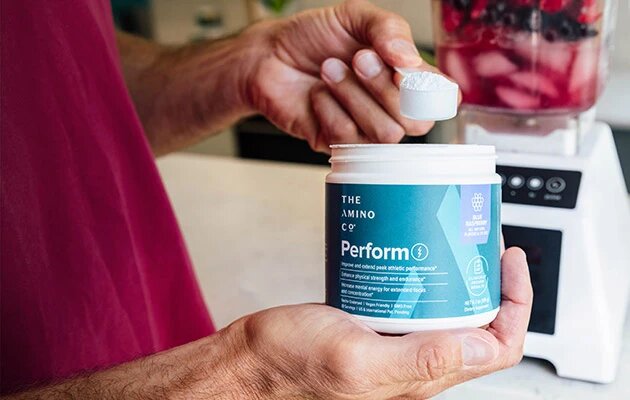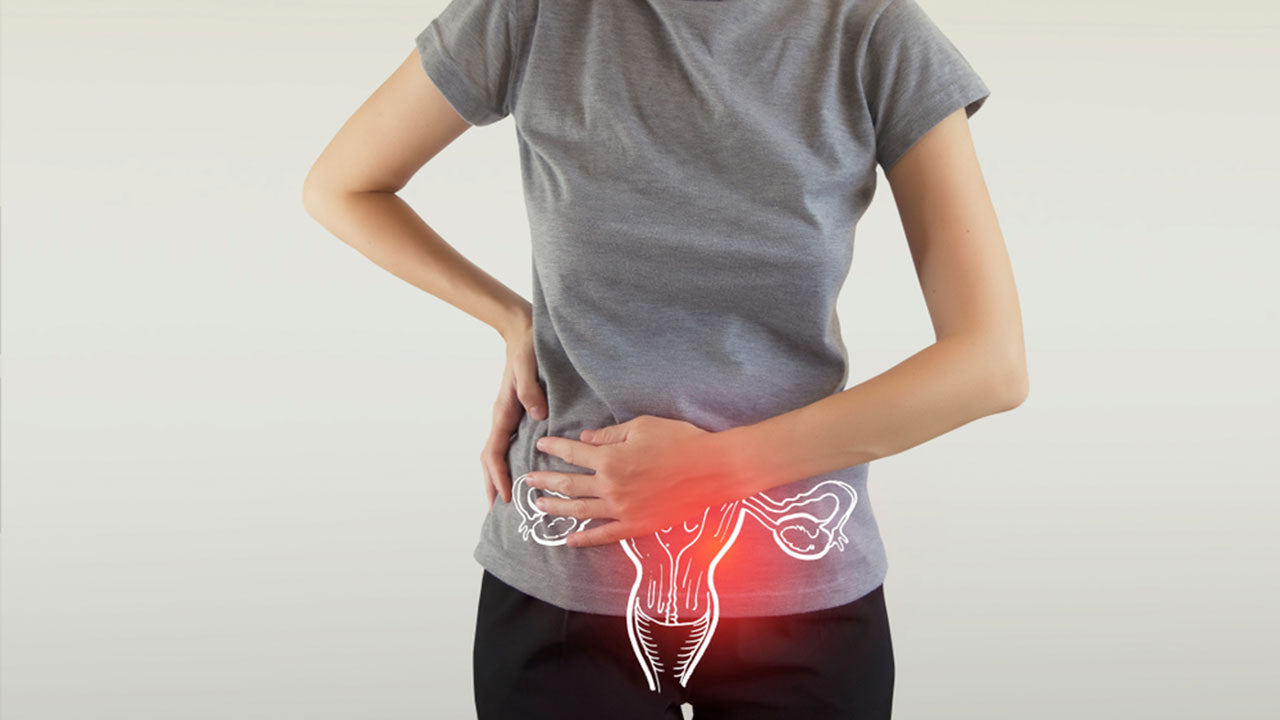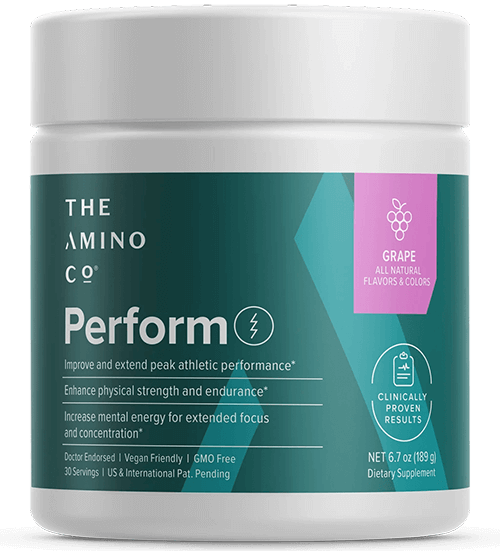Muscle Strains, Sprains and Pulls: How to Heal Quickly and Protect Yourself with Amino Acids
 By: by Amino Science
By: by Amino Science

Muscle strains are common injuries—especially for athletes and individuals with jobs that require heavy lifting. Muscle strains in the back cause significant pain and stiffness and may affect your quality of life. How long does it take for a pulled muscle or a muscle strain to heal? It depends on the severity of the injury and how you choose to treat the injury.
Severe muscle injuries, including muscle sprains and strains, limit your range of motion, depending on where the injury occurs. For example, a muscle strain may require time off work or time away from the gym to allow the muscle tissue to heal properly. Conventional muscle strain treatments, as well as natural remedies such as physical therapy, amino acid supplements, massage, and other techniques, can hasten recovery time.
The best advice? Avoid muscle injuries by warming up before exercising and by lifting heavy objects correctly (use those legs!).
What Is a Muscle Strain?
Muscle strains occur when muscles are overstretched to the point of tearing muscle fibers. Muscle injuries that involve torn muscle tissue can range from mild to severe. Mild cases, for example, only affect a few of the muscle fibers in the group while the surrounding muscles remain intact. On the other side of the scale, severely strained muscles are torn to the extent that the muscle is unable to function correctly.
According to Harvard Medical School, there are three grades of muscle strains defined by the severity of the damage:
- Grade 1 strain: A grade 1 strain is the mildest of the three grades, causing the muscle to be painful and tender, but to retain its normal strength. Typically, only a few muscle fibers have been damaged and the surrounding fibers continue to function appropriately, allowing for full range of motion and weight-bearing activities.
- Grade 2 strain: This grade of strain is considered moderate and causes muscle pain and tenderness. The surrounding area may swell and bruise. In a grade 2 muscle strain, a significant loss of strength and range of motion may occur.
- Grade 3 strain: If a muscle tears all the way through, separating the muscle into two pieces, it is considered a grade 3 strain. Grade 3 strains cause complete loss of muscle function, significant pain, a visible dent under the skin, discoloration or a bruise, and swollen tissue. A grade 3 muscle strain is considered a serious injury and needs to be evaluated by a healthcare professional.
Delayed-Onset Muscle Soreness, or DOMS, presents similarly to a grade 1 muscle strain. DOMS is the result of exercise—or overexercise—and the pain typically appears within 48 hours after exercising and lasts for a few days. Rubbing the muscle and gentle stretching will help the injury heal and relieve pain and tightness.
Muscle Strain Symptoms
Muscle strain symptoms depend on the location of the injury and severity. Recognized signs of a muscle strain may include:
- An audible "pop" at the time of injury, indicating a grade 3 strain
- A gap or visible change in the normal outline of a muscle, suggesting a grade 3 strain
- A decrease in muscle strength, indicating a grade 2 strain—with complete loss of muscle function signifying a grade 3 strain
- Swelling, bruising, or both at the site of injury
- Muscle cramps or spasms
- Generalized muscle pain and tenderness that increase with movement
- Charlie horse-type pain
- Painful muscle knots
Certain areas of the body may present with slightly different symptoms of muscle damage including:
- Low back strain: If you have a low back muscle strain, the back pain will likely radiate into the buttocks. A low back strain causes stiffness and often restricts the range of motion. The injury may cause spasms, poor posture, and significant pain, even while at rest.
- Forearm muscle strain: When you experience problems flexing the fingers or wrist, or pain, swelling, and muscle spasms, you may have a forearm muscle strain. A forearm muscle strain is often caused by physical trauma, overuse, or repetitive movements.
- Hamstring strain: Hamstring strains are very common injuries for competitive athletes. According to the Mayo Clinic, this type of muscle injury often is related to poor flexibility, muscle imbalance, or a prior hamstring injury.
- Neck strain: Necks are incredibly susceptible to injury. There are over 20 muscles connected to the neck that facilitate the movement of the shoulders, upper back, jaw, neck, and head. Neck strains may cause sharp localized pain that aches or throbs, stiffness, muscle spasms, and inflammation, and the pain often worsens with movement.
NOTE: An Achilles tendon rupture can cause an audible "pop" like a grade 3 strain, as well as immediate sharp pain in the lower leg and ankle. The Achilles tendon is not a muscle, and if you experience significant pain or the inability to bend your foot or stand on your toes, see your doctor immediately for evaluation and treatment.

Diagnosis and Muscle Strain Treatment
If you believe you have a grade 2 or a grade 3 muscle strain, see your sports medicine healthcare team as soon as possible. Your doctor will physically examine the area, testing range of motion, pain, flexibility, and strength. If your symptoms are moderate to severe, X-rays or an MRI may be required to determine the extent of the damage to the muscle so the best treatment for your muscle strain can begin.
If you have a minor muscle strain, your doctor may recommend the R.I.C.E. method:
- Rest: Allow the muscle to repair by minimizing use for a few days or until pain abates.
- Ice: Apply ice for 10 to 15 minutes every hour for the first 24 hours, and then every 3 to 4 hours, or as necessary.
- Compression: Wear a compression wrap or undergarment for the first few days after you've injured your muscle to relieve pain.
- Elevation: For the first few days after injury, elevate the muscle above the heart to reduce swelling.
For minor muscle sprains, your physician will likely suggest an over-the-counter anti-inflammatory medication like ibuprofen and encourage you to begin stretching the muscle after a few days of healing. If the stretching causes pain, give yourself a few extra days to allow the injured muscles to repair.
Grade 2 and grade 3 strains may require prescribed pain relievers and muscle relaxants to relieve discomfort. Severe strains may require a trip to an orthopedic specialist. Depending on the location and severity of the strain, immobilization for a few weeks may be necessary. In severe cases, surgery and physical therapy may be required.
When healing from a sports injury, even a minor muscle strain, it would be wise to consult with a physical therapist who can design a customized recovery and exercise program for you. The last thing you want to do is cause further damage or re-injure your muscle. A sports medicine-minded physical therapist can teach you to exercise properly to spur healing and to create muscles that are strong and flexible, so reinjury of the muscle is less likely.
Amino Acids and Muscle Recovery and Health
For all grades of muscle tear damage, taking a full-spectrum amino acid supplement spurs healing of muscle damage when consumed in the days following injury according to a study published in the International Journal of Sport Nutrition and Exercise Metabolism. Researchers from Australia investigated a supplement that contained the nine essential amino acids as well as three nonessential amino acids. Findings support the use of an amino acid supplement 30 minutes prior to working out and immediately upon completion of the workout to reduce muscle soreness and delayed-onset muscle soreness.
Amino acids are required for muscle growth, muscle building, and pain management. If you are looking to heal a muscle strain or other muscle injury—an amino acid supplement is a must. According to an article in the journal Practical Pain Management, amino acids are responsible for three key pain-modulating neurotransmitters, and balanced amino acid supplementation can reduce pain and even reduce the dose of prescription painkillers that are necessary for severe pain. The article further explains that the human body's entire pain-relief system is fueled by amino acids and the hormones they produce.
4 Essential Tips to Prevent Muscle Strains and Sprains
Preventing injury is always better than treatment! Use these four tips to help prevent muscle injuries including pulls, tears, and sprains.
- Warm up your muscles properly before exercising or moving heavy objects. Just 5 minutes of light stretching can protect you from injury.
- Take an amino acid supplement 30 minutes before you exercise and immediately following the workout to protect your muscles and improve performance. We recommend Perform, clinically proven to enhance strength, focus, and endurance.
- Learn how to lift heavy objects safely by squatting down instead of bending over to prevent mild strains or more severe lower back injuries.
- Under the guidance of a physical therapist or sports medicine professional, create a balanced exercise routine that includes aerobic activity, stretching, balance work, resistance exercise, and weight lifting.

Up to 25% off Amino
Shop NowComments (0)
Most Craveable Recipes




 833-264-6620
833-264-6620



















